
TANA
Gallery Bookshelf
TOKYO | KANDA
| 110904 | Oyama Enrico Isamu Letter I Know You Don't Really Care, For It 11.09.04 SUN -11.09.25 SUN |
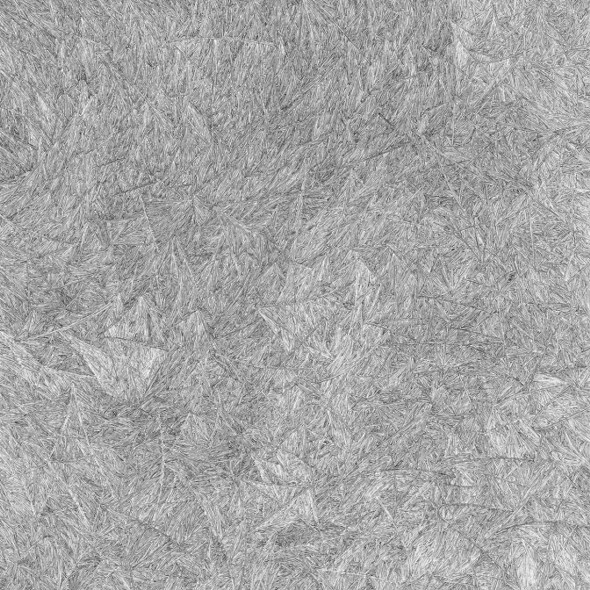
Line, curve and quick-turn - decomposing graffiti / lettering once to its basic elements, Oyama Enrico Isamu Letter originates an abstract motif called Quick Turn Structure out there. Autonomy of the form, and its autopoietic expansion / propagation. Or, bodily operations driven at multiple levels, i.e., finger, wrist, shoulder or waist and back. The patterned principles are regularly executed without deviating from themselves. Through inevitable friction with diverse media such as the wall surface, canvas, drawing papers, or even sometimes space itself, however, QTS cannot help varying its expressions or materials. Thus, the trace=representation of its movement to be left as a work differs every time it comes into being. Still, the logic itself preceding the movement seems to be preserved - but, for sure?
Be it true or false, TANA Gallery Bookshelf presents his solo exhibition "I Know You Don't Really Care, For it" as a trace of conflicting relation taking place between QTS and unique limitations given to the gallery space.
Event
Artist Talk & Opening Party
2011.09.04 (Sun)
6pm-
Artist Talk
(in Japanese)
8pm-
Opening Party
(DJ: Oyama Enrico Isamu Letter, Nothto, and TANA)
| Appx |
At the opening of "I Know You Don't Really Care, For It" we held a talk session with Oyama Enrico Isamu Letter to revisit his activities throughout his career and investigate thoughts and philosophies in his works/projects. The following interview is based on the interview at the opening and reconstructed with several exchanges via email.
- To begin with, please let us learn about yourself.
In my childhood I loved painting, drawing and scribbling all the time. I had a relative who was good at making comic characters, and I was into video games as well. I feel those influences play a significant role. But I was not particularly interested in art at that time. Similar to many children in Japan, I cherished comics and video games, and just simply made scribbling of those characters. Rather I wanted to become a musician until around my junior high school days.
I came across so-called graffiti when I was a high school student, which was a very shocking event to my life. I was born in Tokyo and brought up there, but I came to live in Italy for one year from age 16 to 17 as my father is Italian, and I began making graffiti shortly after that. As I knew nobody making graffiti around me in those days, it was at most like pretending other graffiti writers, having tried several pieces of street drawings.
Upon entering a university, I naturally began live-painting in clubs since I was close to people like DJs or event organizers. I was 19 year old when I conducted my first live-painting at a club in Shimokitazawa, which made me engaged with Tokyo club scenes. Since then till I became 23 I had tried live-painting in any type of clubs, such as Milk in Ebisu, perhaps twice or three times a week, more than 100 a year. Although I had produced works on canvas or as murals too, it was live-painting that I produced most in those days. I met many painters who had been making similar activities all around Japan, and the networks expanded through live-painting.
In the meantime I entered a graduate school of an art university in 2007, which I think broadened my perspective drastically. There I discovered values that are unique to contemporary art or art criticism, something different from those of clubs or street culture to which I had been accustomed. Though they appeared rather alien to me in the beginning, I spent long time and absorbed them gradually. For instance, I was likely to see fine art and street art in a binary opposition, but I came to see such a view only schematic.
Quite naturally, both fields contain diverse standpoints and contexts, and they come sometimes very close and sometimes very far. Then I came to reflect upon my work not from categories like fine art or street, but from a viewpoint where these two can overlap and cross-over each other. Consequently, I have so far digested a range of diverse experiences through my activities, produced works regardless of its format such as the mural or the painting, conducted live-painting sessions, and recently come to have more opportunities to write critical reviews and essays.
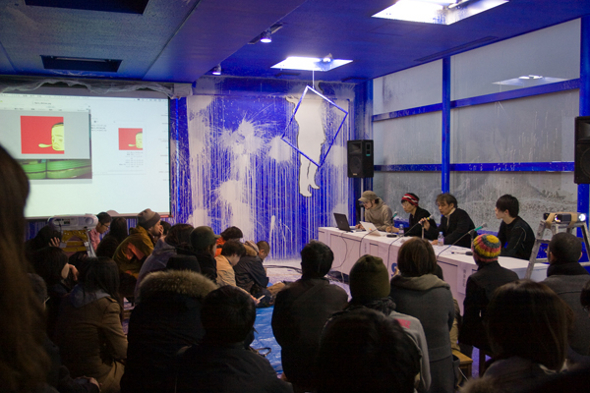 Symposium "Frontier of Post-Graffiti" Panelist: Fumihiro Hayashi, Hiroshi Egaitsu, Oyama Enrico Isamu Letter, Takashi Sakai, Yosikazu Nango Former French Embassy, Tokyo 2009 Photo by Takahiro Tsushima |
- In your development as an artist, did you feel something different before and after you studied at the art university?
Yes, to some extent though. Even before that, I visited a variety of art exhibitions and studied art in my own way, but I had a vague and alienated feeling to art as though just watching it from outside since I had never been acquainted with people actually working inside artworld. I think I had a tendency to assume a single category "contemporary art" in my mind and handle it in a binary opposition like its inside versus outside. Having met many people engaging with contemporary art, I came to feel such a way of thinking went much alleviated. Say, I noticed it's not that simple. Still it was not like something to reset everything. My own experiences I had so far accumulated encountered new experiences, and they were gradually over-painted in a synthetic way.
- Before moving to your activity after the graduate school, let me ask a little more details of your live-painting activity.
Just around when I entered the university as an undergraduate, I had come to have more opportunities to conduct live-painting, and in practice I carried out a considerable number of it until I graduated. Though the university was nothing to do with art, I had based my activities mainly in club scenes and it was as if having my own field outside the school. At the beginning I was simply pleased to have many strangers watching my works in clubs, and it was so exciting to meet various people you may not find in the university and to expand networks that I enthusiastically conducted live-painting sessions as many as possible.
Live-painting was usually carried out with a huge paper on the wall of the club, drawn with ink makers or paints. Having continued such activities for 1 or 2 years, however, I also came to feel its limitations. Since club events normally last for 4 to 5 hours in midnight, live-painting was usually conducted extensively taking long time, which made it difficult to keep audiences' attention, so hardly appreciated carefully in the club setting where people may come mainly for dancing to the music, and there was no unique reason to be performed in live as an expression. In terms of both space and time, it was conducted largely within the "club" format. I began exploring some other possibilities.
Then I called my friend painters in order to organize the event series "HUOVA" to focus mainly on live-painting itself, eventually holding it three times in 2006 at the Conceal Gallery in Shibuya. "HUOVA" was composed of 5 painters, each with one side of the wall, performing live-painting one after another, and performance time was limited as 20 minutes to let them concentrate on improvisation and maintain audiences' attention. In those days there were only a few events which mainly devoted to live-painting in particular, and the concept of limiting the performance time to 20 minutes was exceptional even among those. Nevertheless gHUOVAh managed to draw attention, eventually gathering about 250 people as the audience.
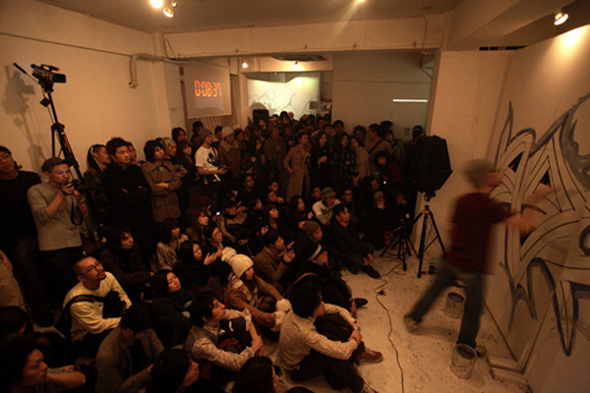 "HUOVA" Participating Artists: JonJon Green, Kaz, Kohei Yamao, LOOT, Mako, Oyama Enrico Isamu Letter, Que Houxo, Rei, Sal, Sense, Tomoyuki Washio Gallery Conceal, Tokyo 2006 (3 times through a year) |
Just around when I launched "HUOVA", I also started research on graffiti and street art in a laboratory of the art university. It was only a graduation thesis and too modest to be called "research" though, I attempted to examine the context of what I had been engaging with. Now I've come to have more opportunities to write essays while producing works as an artist, but my consciousness to verbalize my own activities was already prepared at that time.
- Can I understand that you had organized a series of events like "HUOVA" as a unique format adequate to live-painting expression?
Yes I had so intended. Besides, I had another intention to make the live-painting scene visible. Recently more people have come to conduct live-painting everywhere, but there were only a few, even countable in all around Japan, who had such activities when I started it. Although those painters had their own networks, the whole picture as a scene was hardly visible. "HUOVA" aimed at presenting the live-painting scene, even if its demonstration could be only partial.
Having experimented the aim in practice, I could understand many things. One is that the live-painting, although being identical in the name, has various backgrounds, contexts and directions among different people. I know one who began live-painting as he found limits in his studying at the art university, while I, in contrast, began "HUOVA" as I felt limits in activities at clubs, then entered the art university and acquired broader perspectives. There are graffiti or live-painting on one hand, and contemporary art or art education on the other, to which different people approach in different manners and distances.
Thus, as I told already, my current perspective is to accept plural contexts that cross over within the balance of each artist, and various scenes that overlap and deviate one another as dynamic relations full of graduations, without easily labelling them as fine art, sub-culture, live-painting and the likes. This sounds very natural, but I have come to understand it as the genuine feeling through my activities and experiences of live-painting or event-organizing.
- Let's move to your works. You have explored various media such as murals and paintings with a motif called "Quick Turn Structure". Can you tell us what the QTS is like?
Quick Turn Structure is a motif I have continued from the earliest days, which is a unique construction language developed from influences of the lettering in graffiti or of my live-painting activities. When I became interested in graffiti for the first time, it was its visual impact that had influenced me. As I came to know graffiti through books or zines, the encounter was initially made as a visual phenomenon. Consequently, I had once been always drawing lettering patterns on papers before I started live-painting.
What I felt very naturally at that time was that I was attracted by the visual construction elements in graffiti and lettering. Lines overlapping or deviating one another, turn, cut-off, sharp curves, and visual effects resulting from combinations of those elements. However, the lettering in graffiti will usually signify those visual construction elements into horizontally aligned letters. As graffiti is originally to engrave their name into the public sphere, readability becomes so important that they must, in the end, keep letters readable while they do distort its figures.
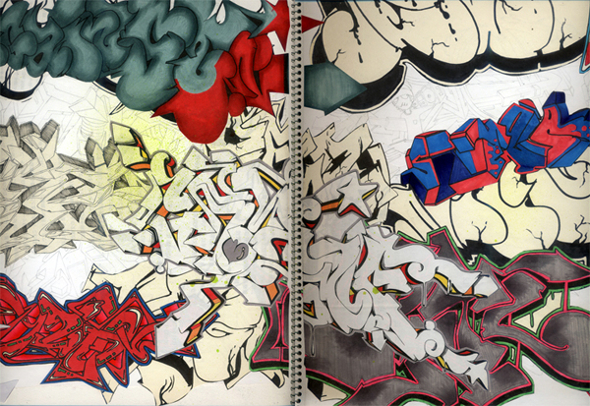 A part of Graffiti-Lettering drawings made through the high school period. |
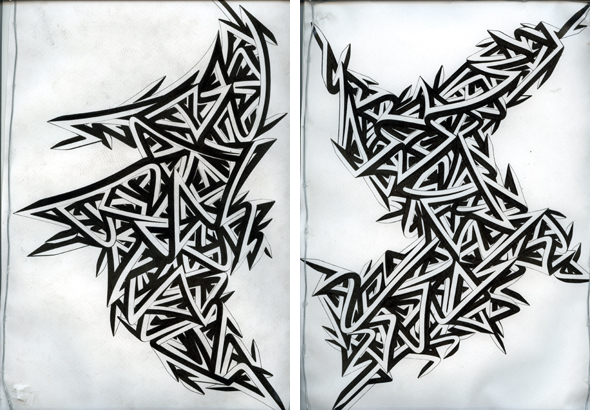 Early drawings based on Quick Turn Structure. Left: FFIGURATI #3 Technical Pen on Paper 297mm ~ 210mm 2007 Right: FFIGURATI #4 Technical Pen on Paper 297mm ~ 210mm 2007 |
QTS seems to have developed through improvised body operation and the resulting dynamism of lines, especially in events like HUOVA that features highly bodily performance. Yet, this bodily feeling or improvisation are neither random nor destructive, rather it is firmly connected with the architectural patterns of QTS so that it has nothing spectacular like action-painting. For example, I use my back and shoulders to draw thin black curves momentumly, then wrists or elbows as an axis to slide them slowly, to curve out edges by painting white planes on the black curves, which manipulates slow and rapid movement, bodily utilities, or the balance of improvised and patterned places, dynamically and structurally drawing QTS out there.
Such a feeling is also common in execution of murals. The interaction of the urban space, textures of walls and scale effects become important all the more in executing the mural. When it comes to the canvas, I put attention to precision or density in details or to competing relation between the canvas and the motif. Depends on the medium to be executed on, the materials and expressions of QTS entail a diverse variety. Be it drawing on street, drawing on the wall as murals, painting at live events, each execution has its own distinctive conditions and historical contexts, so as one vision in my execution I let QTS cross-over such plurality, transform itself and expand its range of expressions.
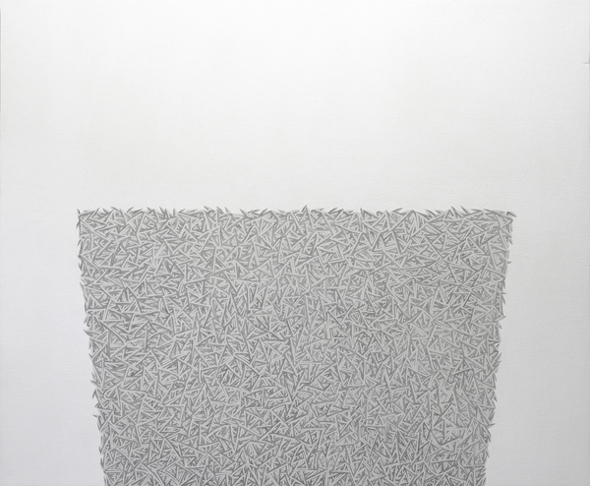 FFIGURATI #13 House Paint and Mechanical Pencil on Wooden Panel 910mm ~ 1110mm 2009 |
Let's approach it from the perspective of the message and the sign. To begin with, a message contains four elements; the addresser, the addressee, the content, and the medium. When one chooses the city as the medium to address a message, "society" is thought to be the addressee since the city is a public space. For instance, scribbling on the street can function as a message addressed to society. In fact, there are many cases throughout the history where scribbling contains social messages whatever they are. Speaking of a remarkable example, many pieces of "scribbling as the message" had been made during the season of world-wide political and cultural turmoil triggered in 1968, as represented by May protest in France. In those days, society had shared the narratives of social classes or ideological struggles as their own reality, so that people had maintained literacy to understand [or decode] those messages addressed to them. That is, the conditions had been prepared so that scribbling could work as the message.
However, especially after the cold war, the cities all over the world had come to transform into the space of coded consumption, where everything functions as the sign. The more one tries to struggle against domination of the sign, the more likely one is encapsulated as a sign in the name of "rebellion" and spoiled as such. In the super-consumptive city like Tokyo, social activities such as street speeches or civil demonstrations are messed up with corporate advertisement or prohibition posters, which altogether may appear as if being the scene out of signs of capitalism and controlling society, or at least it has been difficult for people to feel reality with such [social and civic] activities. In such situations, scribbling, which would once function as the message, has become consumed as a sign, losing its competence. When graffiti emerged for the first time in the 70s, the urban space was just entering this transformation into such a place of the sign.
As French thinker Jean Baudrillard coined it as the "empty signifier", what had made graffiti radical in those days was that it was just simply the name. It's better to explain the term "empty signifier" a little more. Throughout the history many of scribbling have certain sentence structures such as "subject + predicate (+α)" so that one can read its situations or meanings no matter how trivial they would be. In contrast, the name is a sign that is arbitrary, private and intimate from the very beginning, and its meaning cannot be read, unlike scribbling in the "subject + predicate" sentence structure. Especially in graffiti, writers will newly create their own pseudonyms called tag-name by themselves, mostly out of visual and sound impression of the word, so that they are nothing more than graphical images lacking the intrinsic meaning. Then, let's say, scribbling newly came to appear as the sign rather than the message, namely the "empty signifier" not contaminated with the meaning.
This must have appeared as a new threat for the authority. That is, the strategy of the mature capitalism is to diminish and spoil abundance of meanings by encapsulating them into signs [coded objects], but the strategy will get stuck with the "empty signifier = graffiti", since graffiti already comes as a sign and still has no meanings to be diminished at all. In this way, graffiti can be said to have sneaked into the system through the same logic as the sign, instead of directly confronting against it, malfunctioning the dense networks of the meanings by bringing the vacant to its inside. Baudrillard accurately pointed it out 30 years ago as follows:
Graffiti, as an empty expression of the sign, invades the realm of the meaning-laden signs in the urban and dismantles those signs by only manifesting its existence, with its entire absence of the content or the message at all, this empty status empowering graffiti.
(Baurdrillard, Jean. "Kool Killer, or The Insurrection of Signs." Symbolic Exchange and Death, 1976. )
I would like to focus on his expression "just by manifesting its own existence". This overlaps issues of anonymity/manifestation or of literacy, but here I want to focus on the following. If graffiti is the "empty signifier", then how does it manifest itself? Even with the absence of any clues to decode its meanings, what makes it possible is its visual impact of graphic language of Graffiti/Lettering and the choice of places to be written. For example, it is experienced as a moment of unique colorful letters in spray paint jumping into your unconscious glance from the train leaving there rapidly. Or, it is in a momentary encounter with letters on the body of trains passing by in front. These two elements, namely the visual impact and its deployment into the urban space, have enabled graffiti to provoke attention despite being the "empty signifier".
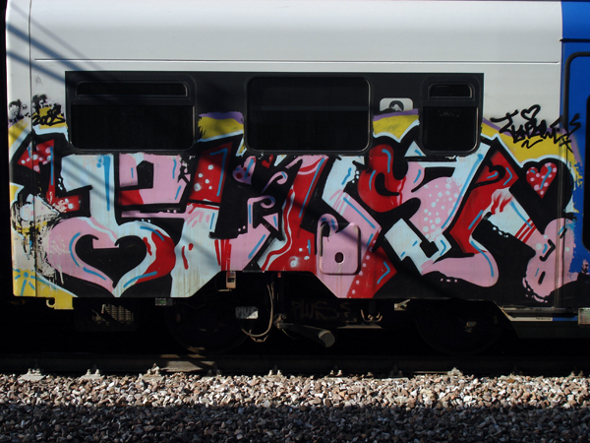 Graffiti on a train car (North Italy, 2009) Photo by Oyama Enrico Isamu Letter |
In the genealogy of graffiti, recent movements of political and guerrilla-style street art can be seen as being flown adversely from the "empty signifier" to the "sign filled with the meaning". Indeed the method of Banksy and others is close to the inspiration of Situationist, who left great influence to cultural movements of the following generations through their activities in Europe in the 50s and 60s, in that the method revolts around manipulation or appropriation of signification particular to specific places in the urban spaces. One of the two elements of graffiti, namely deployment in the urban space as mentioned earlier, has developed into this stream. As a matters of course, the gesture of conducting guerrilla practices in the city will provoke social and political reading all the more.
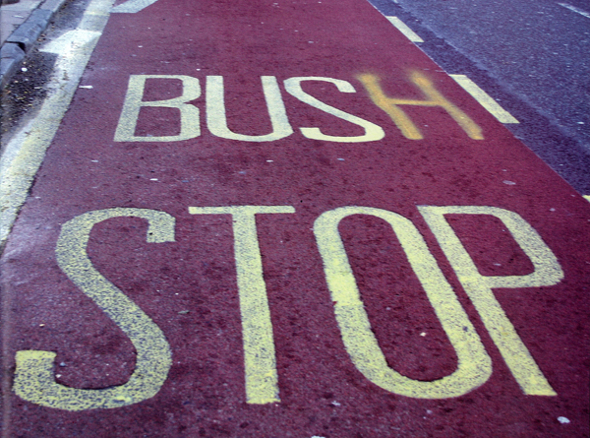 Political street art in London with ironical message created by manipulating/diverting the original meaning. "STREET ART AND THE WAR ON TERROR" Edited by Eleanor Mathieson, texts by Xavier A. Tapies, Rebellion Books, 2007. |
As discussed earlier, QTS can be written on canvas or at live events, or also processed down into products, but there are only temporal reasons being negotiated between QTS and plural media given each time, thus not the singular reason inherent to QTS itself. The intrinsic reason that QTS obeys is only in its visual structure, and it is autopoietic so that it desires to cross over plural media without remaining in a specific medium. QTS generates its forms in each condition or context of the given media, such as the wall (the urban space, the architecture), canvas (the frame, the flat panel), or live performance (temporality, audience). In this cycle QTS may be occasionally revised little by little, but it will not be replaced with a different one all the sudden. I've conceived QTS as maintaining its autonomy, changing gradually by experiencing each execution, recurring back to itself again, and expanding the range of its expressions. The relationship between QTS and media is something like free-agent, and also deracine.
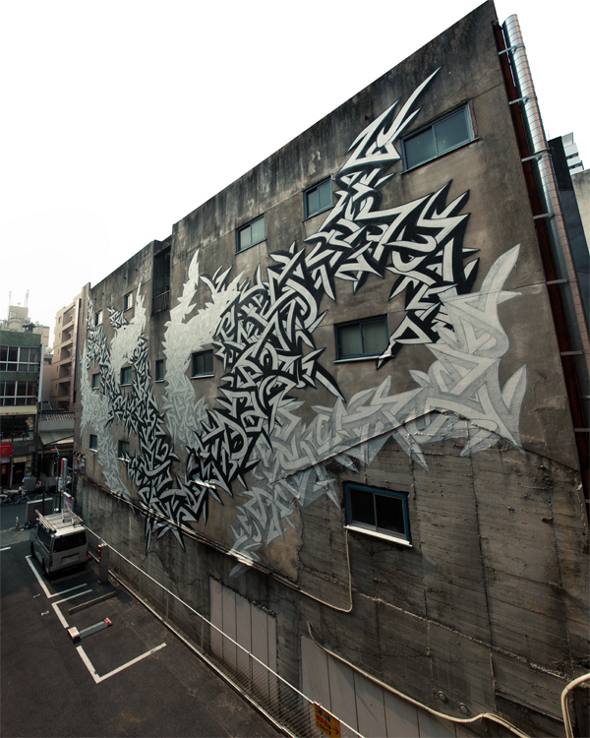 Project "Choja-Machi Mural" (Aichi Triennale 2010) Aerosol and Lacquer Paint on Concrete Wall 13m ~ 15m Choja-Machi, Nagoya (Japan) 2010 Photo by Takahiro Tsushima |
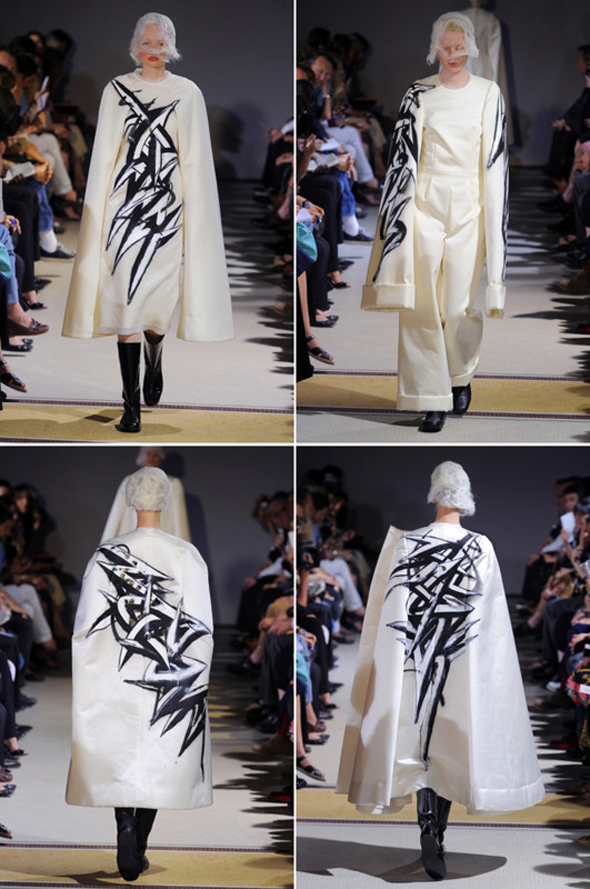 Commission work for COMME des GARÇONS at Paris Collection, 2011. |
 COMME des GARÇONS on runway. Quick Turn Structure appears for about 2 minutes from around 14:00. |
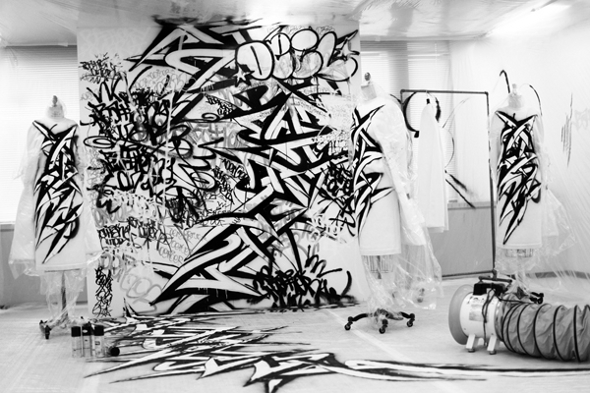 Working site in the office of COMME des GARÇONS (Tokyo, 2011) Photo by Shinpei Yamamori |
"Magnitude Zero at Level 7" at Real Tokyo
Oyama Enrico Isamu Letter
"Rhythm of Francis Alys" at 10+1
Oyama Enrico Isamu Letter
- Please let me ask further about the alteration of QTS through crossing-over plural media.
Although I said QTS is to cross-over various media, I'd like to emphasize that it is never like a solution-oriented thinking, such as cleverly working out the optimal answer in order to comfort QTS into the given media. It is rather totally opposite to such a designer-like manner, and the autopoietic structure of QTS is so robust that it will not change so immediately. Hard to clearly explain though, let's say QTS has its own logic while media have their own, and they conflict and compete each other, through which I feel I produce a work by twisting both of them. There is no manual, and it is always experimental so that sometimes I feel awkward with it, but on the other hand I somewhat expect something weird may spring out of the awkwardness. For instance, I've incorporated grid structure into recent works on flat panels, attempting at slowing the dynamism of QTS drawing. While in live painting I often show free movement of drawing out of bodily movement in improvisation, I also intend differently on canvas.
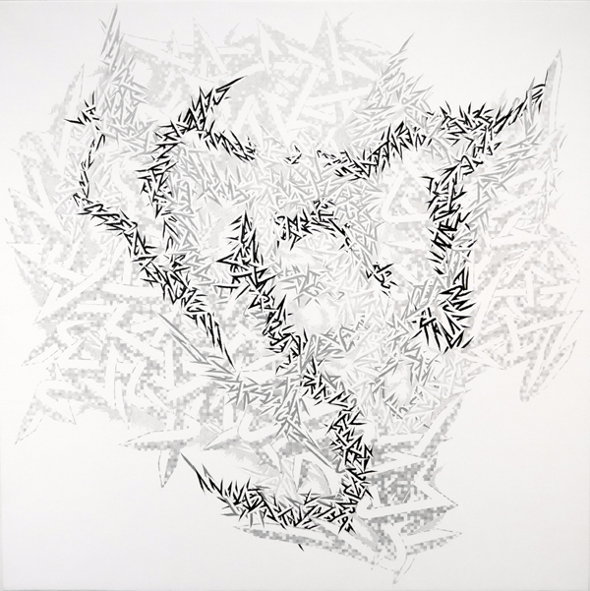 FFIGURATI #17 Gesso, Aerosol, Lacquer Paint, Technical Pen and Mechanical Pencil on Canvas 900mm ~@900mm 2011 |
"FFIGURATI" is the word I invented by twisting the word "graffiti" and adding the nuance of Italian phrase "Figura Ti (Figure you)". Initially I used the word as the title of a small solo show at an exhibition space I produced by renovating a part of my studio, since then I have come to use it mainly for works using QTS for the motif. The mechanism of QTS is intrinsic in QTS itself, which in relation to various media will represent itself in individual works as the trace of the QTS dynamism, and the word "FFIGURATI" corresponds to the level of trace=representation. It may possibly be said to be a two-layer structure. QTS itself is a mechanism of drawing movement, which cannot be directly captured into works. "FFIGURATI" refers to individual works as the fruit of QTS whose dynamism leaves its unique trace at each execution.
- The definition of graffiti is largely relied on its social positionality (being illegal, or at least counter-social even if legal) and media specificity (being written on roads and walls). QTS seems exceptional as it grounds itself on no particular social position or media and deploys its dynamism through crossing over a variety of positions/media. Is QTS simply not graffiti, or is it graffiti that equips graffiti with a new maneuverability, subverts its definition, and expands its realm to act?
I think this is a significant question. I myself don't take QTS to be graffiti at all. Graffiti is a form of culture which has already acquired the style through its own history, and as you pointed, it is an act of writing the name down on the street without permission [illegally]. As argued so far repeatedly, QTS is driven with another distinctive logic, so we don't have to call it graffiti. Still, they are not totally unrelated, but rather strongly connected in a certain way. It must be a heavily twisted relation. On both theoretical and intuitive levels, QTS attempts to use the twist as a spring to jump further away from graffiti. I feel QTS as such.
- Thank you for exploring a range of topics for this interview. Would you have anything you'd like to mention here?
On the above mentioned solo show "FFIGURATI" in 2009, there is a brief review by a researcher/art-critic Masaya Chiba. Very short but quite accurate, the review would have something in common with this interview, so I'd like to recommend it as well. Thank you for interviewing.
"Post/Pasta-Graffiti - Oyama Enrico Isamu Letter 'FIGGURATI'"
Masaya Chiba
Oyama Enrico Isamu Letter
Artist. Born in Tokyo, 1983, from an Italian father and a Japanese mother. Keio University (Bachelor), Tokyo University of the Arts (Master). gQuick Turn Structureh is the recurrent motif of his work including painting, installation and mural. Based on his very unique perspective across contemporary art and street art, his practice also expands to writing critical essays, participating symposia and commission works such as one for COMME des GARÇONS in Paris Collection 2011. Principal exhibitions: gAichi Triennale 2010h(Nagoya City, 2010), "Padiglione Italia nel mondo : Biennale di Venezia 2011"(Italian Cultural Council Tokyo, 2011). Principal thesis: "Banksy's Literacy - From Surveillance Gaze toward Transparent Sight"(EUREKA, August 2011 Issue, Seido-sha). 2011 Fellowship of Asian Cultural Council (New York).
http://www.enricoletter.net
Interview in Japanese
| Current | Archive | About |